We all know that eating fruits and vegetables is good for us. This is a message we have heard since we were kids. The USDA recommends eating 5-9 servings of fruits and vegetables per day. However, nutrition experts and research suggest that more is better, typically agreeing that at least 8-10 servings of fruits and vegetables per day is best.
The more #fruits and #vegetables you eat, the healthier you are! #eattherainbow #saslife Click To TweetRich in phytonutrients, fiber, vitamins and minerals, eating more fruits and vegetables will improve just about every aspect of your health. Plant foods contain thousands of phytonutrients, which are compounds that have dramatic effects in our bodies and give plants color. This is why you always hear about the importance of “eating the rainbow.” Check out this handout for ideas about which fruits and vegetables fall into the different color categories along with benefits associated with those colors or phytonutrients. You can use this handout as a guide to encourage variety in your produce selection.
One meta-analysis study showed that 7.8 million deaths worldwide could be prevented each year if we just ate more fruits and vegetables. They found that eating 10 servings of fruits and vegetables per day (mostly vegetables) resulted in:
- 24% reduced risk of heart disease
- 33% reduced risk of stroke
- 28% reduced risk of cardiovascular disease
- 13% reduced risk of cancer
- 31% reduction in premature death
Another study from the American Journal of Public Health (2016) found that when you increase your fruit and vegetable intake you are happier!
And these are just two examples of the thousands of studies out there that show the benefits of eating fruits and vegetables.
The Details
Optimally these recommended 8-10 servings would be mostly colorful, non-starchy vegetables with around 2-3 servings of fruit.
What is a Serving?
- Vegetables: one serving = ½ cup raw, frozen or cooked vegetables, or 1 cup raw, green, leafy vegetables.
- Fruits: one serving = in general ½ cup fresh and ¼ cup dried, but it can vary by fruit. Check out this table for more info.
Don’t Waste!
Buying fresh fruits and vegetables can be expensive, so make sure you don’t throw away nutritious parts.
- When vegetables begin to look a bit wilted, chop them and make soup.
- Keep a bag in the freezer for slightly too old veggies, or parts that were chopped off to use later for soups or stock.
- Freeze over-ripe fruits to use in smoothies.
And don’t throw away the leaves and stems! These can be used in smoothies, soups or a variety of other ways.
Does Juicing Count?
Nope. But you can do smoothies. Juicing removes the fiber and some of the nutrients. Making a smoothie (with a high-speed blender) will retain the entire vegetable including the fiber. It can also be an easy way to fit in 2-3 servings of vegetables. Just make sure to not over-do the fruits in your morning smoothie and always include a source of protein and healthy fat.
Does it Have to Be Fresh?
Any form of fruit or vegetable is better than no fruits and vegetables. But of course, the fresher it is the more nutrients it will contain. Here is an order of preference:
- Purchased fresh from a local farmers market (or from your garden)
- Purchased fresh from the store, from a regional farm
- Frozen (without added sugar/unnecessary additives)
- Purchased fresh from the store, from across the country
- Purchased fresh from the store, from overseas
- Canned
How to Do This
Vegetables
Consider prepping your veggies as soon as you get home. Wash, chop and store in clear storage containers so everything is clean, easy to see and ready to go! You will be much more likely to make a salad or stir fry or just snack on raw veggies if they are already prepped. Don’t forget to keep the leaves and stems too! You can also purchase already prepped veggies from the store or salad bar.
Cooking methods can alter the amounts of nutrients in your veggies. Steaming is the preferred method, but roasting and sautéing is fine as well. Just don’t boil your vegetables, unless you are making a soup. Don’t worry too much about the specifics, eat some raw, cook some, do whatever you can that will help you enjoy eating vegetables (so that you eat more).
Fruits
Most of us don't have a problem getting 2 servings of fruit per day as they make for an easy snack or addition to most meals. If you find that you are having trouble remembering to incorporate fruit, try keeping a fruit bowl on the counter to keep them in sight.
Can I Just Take Supplements? I Don’t Like Vegetables.
Vegetables and colorful fruits contain thousands of compounds all acting synergistically in our body to support the functions of our cells. Supplements cannot do the same.
If you don’t like vegetables, or are looking for more ways to add them in, start here.
Do I Have to Buy Organic?
Minimizing exposure to pesticides, insecticides, herbicides, and GMOs is the main reason to buy organically grown food. They may or may not be more expensive. Using the annual “Dirty Dozen” and “Clean 15” lists from the Environmental Working Group can help guide purchase decisions.
What it Looks Like to Eat 8-10 Servings per Day
In general, you can aim for 3 servings per meal for 9 servings total, or 4 with lunch and dinner and 1-2 at breakfast. If you eat snacks that is another way to fit in more servings.
Here are some examples based on my meals (which I typically share with my 3-year-old) that can be mixed and matched to add up to 2-3 servings of fruit and 8-12 servings of vegetables.
Your Turn!
Ease into this change. It can take your GI system a little time to adjust to the increase in fiber.
- Start by assessing how many servings of fruits and vegetables you typically get in a day.
- Then start to slowly increase that number. Some is better than none. If you currently eat one serving per day, increase it to 2 servings per day then work up from there.
Winter Veggie Coleslaw
Recipe From: FedandFit.com
Makes 8 servings
Ingredients
For the dressing:
¼ cup low sodium tamari or coconut aminos
2 Tbsp tahini or almond butter (or your favorite nut butter)
2 Tbsp fresh lemon juice (about 1 small lemon)
1 Tbsp honey or maple syrup
2 tsp apple cider vinegar
¼ tsp fine sea salt
For the slaw:
1 bunch kale, de-stemmed and finely chopped
½ head purple cabbage, finely chopped
2 large carrots, shaved into ribbons
1 cup pomegranate seeds
½ cup raw cashews, lightly chopped
fresh cracked black pepper, to taste
Directions
- For the dressing, add all the ingredients together in a small bowl and whisk to combine until even and creamy. Set aside.
- For the slaw, add the kale, cabbage, and carrots together into a large mixing bowl. Pour the dressing over the slaw and mix to thoroughly combine.
- Pour the slaw into your serving bowl and top with the pomegranate seeds, cashews, and black pepper.
- Enjoy right away or store for serving the next day!
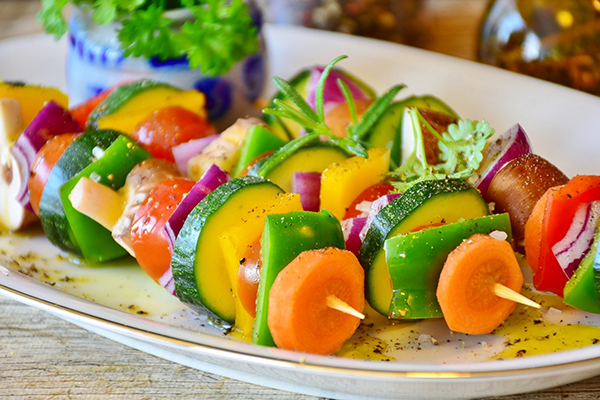


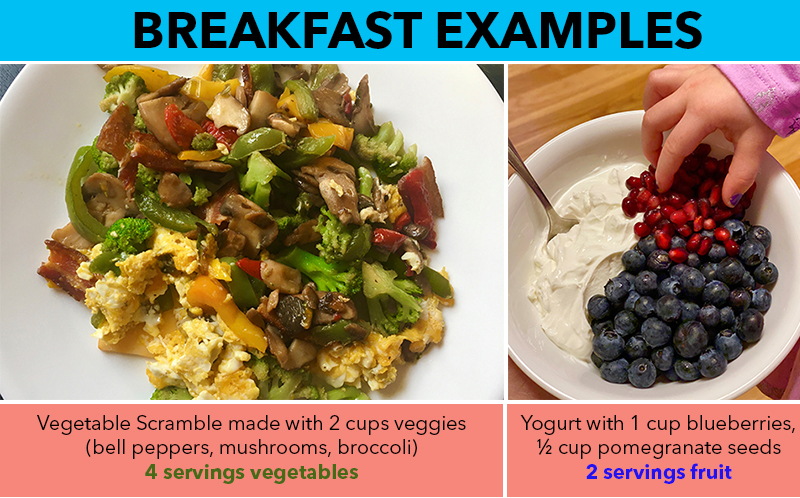


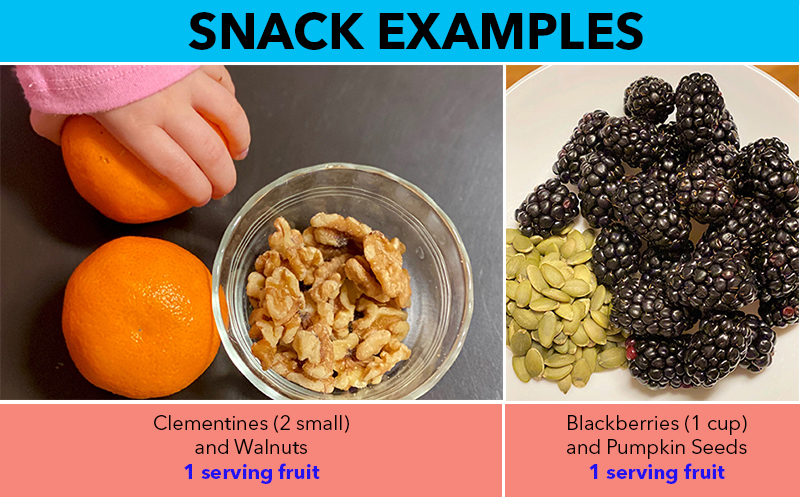
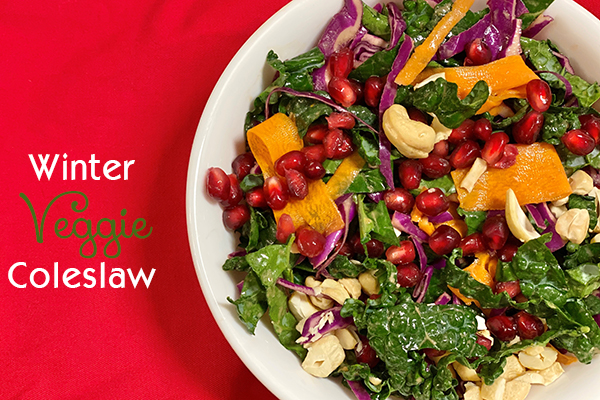
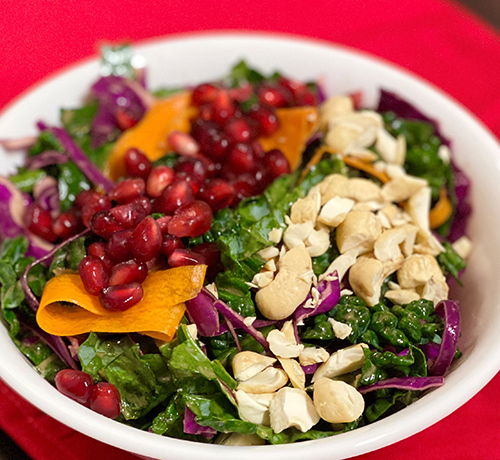

3 Comments
Love these ideas! I use a tracking app called "Daily Dozen" which suggests 1 serving of berries, 3 servings of other fruits, 1 serving of cruciferous vegetables, 2 servings of greens, and 2 servings of other vegetables, among other suggestions. I find that if I have a smoothie and a big salad at some point during the day, I can check off most of those items!
That's great! There is another app called VegHunter that I thought was fun, you track vegetable intake with a focus on getting all the colors.
Great ideas!